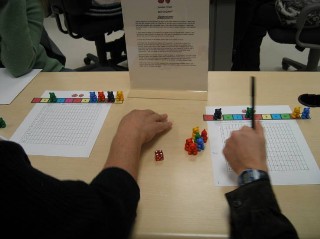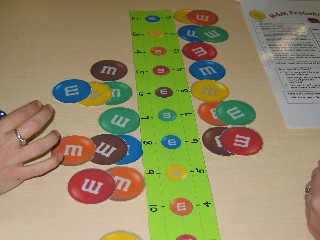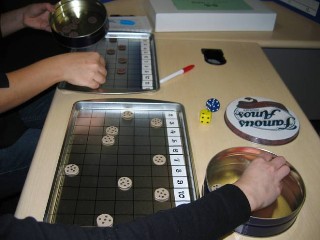
Featured Data Analysis Activity: Two-Dice Toss Data Collection
TWO DICE: Once students realize that the outcomes of tossing one die are equally likely, they sometimes transfer that knowledge to tossing two dice. This is a common misconception that is best addressed through data collection and analyzing that data rather than through telling. See suggested two-dice games below that students can play to gain experiential knowledge of the results of tossing two dice. Several of the games encourage students to develop better strategies in order to win and their growing understanding of probability will be shaped by these experiences.
After students have had several informal game-playing sessions, introduce the charting of the outcomes of throwing two dice. It is very helpful to give students two different colored dice as they ponder this problem so that they see that they can toss a 3 on the red die and a 4 on the blue die AND vice versa: a 4 on the red die and a 3 on the blue die. Both sum to 7 so they represent two DIFFERENT ways to toss a sum of seven.
- Download
 Two Dice Frequency Chart that requires students to toss two different colored dice, then record both the sum and the numbers thrown on each die.
Two Dice Frequency Chart that requires students to toss two different colored dice, then record both the sum and the numbers thrown on each die.
- Download
 Two Dice Toss Recording Sheet that can be used as a simple Two-Dice Toss gameboard and to have students create a reference chart of the dice combinations that yield each sum.
Two Dice Toss Recording Sheet that can be used as a simple Two-Dice Toss gameboard and to have students create a reference chart of the dice combinations that yield each sum.
Two-Dice Games

Game of Pig: 2-dice version: Students should be familiar with the one-die version of Pig before playing the 2-dice version. Tossing a one on either die means that the player loses all points collected in that round, if he/she has not stopped before the one is thrown. Any player who is still playing when snake-eyes (double ones) are thrown, loses all points collected thus far in the whole game!
- Game Analysis:Students need to develop different strategies for playing this 2-dice version of Pig. After playing several times, student pairs might analyze the two-dice frequency chart to calculate the probability of a one being tossed. Students can use this information to develop a winning strategy and compete against other teams to see whose strategy is most successful.
- See
 Directions for the 2-dice version of Pig.
Directions for the 2-dice version of Pig.

Game of Skunk: 2-dice version: After students have mastered the Pig Game, analyzed the probability of the game and identified winning strategies, introduce the Game of Skunk and challenge students to analyze the probability used in this game and develop a winning strategy. How are the games alike and how are they different? Does the same "winning strategy" work for both games?
- See
 Skunk Game Lesson plan, materials and objectives from NCTM Illuminations.
Skunk Game Lesson plan, materials and objectives from NCTM Illuminations.
- Download
 Skunk Game worksheet that can be used in sheet protector.
Skunk Game worksheet that can be used in sheet protector.

Face Off! Game: 2-dice Version Students place 10 markers on the numbers 2-12, leaving one spot blank. Students toss two 6-sided dice, find the sum and remove a marker from that number, if there is still one. The first player to remove all markers wins the game. This game can be used as addition practice or as an introduction to the probability of the different outcomes of rolling two dice.
NOTE: This game was developed by Lindsay Cirelli, a Monmouth University student, for the ED 556 Probability Fair. Ms. Cirelli used a numbered strip and teddy bear counters in her game, as pictured. The gamemat below can be used in lieu of these strips or it can be cut apart to create the strips.
- Download the
 Face Off! Game directions, gamemat, recording sheet and center icons.
Face Off! Game directions, gamemat, recording sheet and center icons.

M and M Game: 2-dice Version Students place M&M markers on the numbers 2-12. Students may place one M&M marker on each number or place several on some numbers and leave other numbers blank. Next, students toss two 6-sided dice, find the sum, and remove an M&M marker from that number, if there is still one. The first player to remove all markers wins the game.
NOTE: This game was developed by Susie Siegel who currently teaches fourth grade at Irwin Elementary School in East Brunswick, NJ. Ms. Siegel created M&M markers on the computer and used sentence strips for the gameboard, as pictured. She also designed a recording sheet students could also use to play the game and record data.
- Download Ms. Siegel's
 M & M Probability Game Directions and recording sheet.
M & M Probability Game Directions and recording sheet.
- Download picture, an alternate recording sheet and
 directions for using the recording sheet that can be inserted in a sheet protector as an alternative to playing the game with M&M pieces.
directions for using the recording sheet that can be inserted in a sheet protector as an alternative to playing the game with M&M pieces.

The Great Cookie Contest Game Who can pack all of the cookies first? Students place cookies on the numbers 2-12 on the cookie sheet. Students may choose to place one cookie on each number or to place multiple cookies on some numbers while leaving others blank. Students then toss two 6-sided dice, find the sum and remove a cookie from that number, if there is one, and pack it in the cookie tin. The first player to pack all his/her cookies in the cookie tin wins the race. This game can be used as addition practice or as an introduction to the probability of the different outcomes of rolling two dice. A good working knowledge of the outcomes of tossing two dice is definitely an advantage in placing the cookies on the cookie sheet.
NOTE: This game was developed by Kristen Yepello who currently teaches fourth grade at Wolf Hill School in Oceanport, NJ. Ms. Yepello used wooden cutouts for cookies. She placed magnetic tape on the back of each cookie so that they would adhere to the cookie sheet. Cookie tins relabeled for popular cookie companies completed the presentation, as shown in the picture.
- Download Ms. Yepello's
 Great Cookie Contest Directions and
Great Cookie Contest Directions and  Great Cookie Contest Recording Sheet.
Great Cookie Contest Recording Sheet.
- Download the
 Great Cookie Contest Cookie Sheet Mat for lamination or use in sheet protector as an alternative to the real cookie sheet and cookies.
Great Cookie Contest Cookie Sheet Mat for lamination or use in sheet protector as an alternative to the real cookie sheet and cookies.

Release the Prisoners Game: who will free their prisoners first? Students place prisoners in any of the prison cells. They then use subtraction facts to find the difference of two dice and free a prisoner from that cell. Careful consideration of the probability embedded in this game allows students to more effectively place prisoners to be freed. Directions plus both the 6-sided dice and 12-sided dice gameboards are included so teachers can target subtraction practice while helping students develop an intuitive appreciation of probability.
- Download the
 Release the Prisoners Game directions and gameboards for both the 6-sided dice and 12-sided dice versions.
Release the Prisoners Game directions and gameboards for both the 6-sided dice and 12-sided dice versions.
- Download the
 Release the Prisoners Game Recording Sheet
Release the Prisoners Game Recording Sheet

Free the Animals Game: who will free their animals first? Students toss two dice, calculate the difference and free an animal from that number cage. Younger students will enjoy this animal version of the Release the Prisoners game and learn subtraction facts as well. Both the 6-sided dice game mat and the 12-sided dice game mat are included with directions.
- Download the
 Free the Animals Game directions and game mats for 6-sided dice to practice easier subtraction facts or 12-sided dice to practice harder subtraction facts.
Free the Animals Game directions and game mats for 6-sided dice to practice easier subtraction facts or 12-sided dice to practice harder subtraction facts.
- Download the
 Free the Animals Game Recording Sheet, designed so that students can track how many animals each player places in his/her cages and who wins. Hopefully, students will learn something about probability while mastering subtraction facts.
Free the Animals Game Recording Sheet, designed so that students can track how many animals each player places in his/her cages and who wins. Hopefully, students will learn something about probability while mastering subtraction facts.
Links: Online Two-Dice Toss Resources
Students can investigate two-dice games online and collect additional data to analyze the frequency of dice sums.

- See
 Dice Roll for online two-dice toss that creates a graph of the results.
Dice Roll for online two-dice toss that creates a graph of the results.
-
 Play 2-dice Pig online.
Play 2-dice Pig online.
- Play
 Online Skunk Game rolls dice and gives directions. Players must keep their own scoreboards. This is an effective way to use a large monitor or whiteboard to play the game with the full class.
Online Skunk Game rolls dice and gives directions. Players must keep their own scoreboards. This is an effective way to use a large monitor or whiteboard to play the game with the full class.
- See
 The Dice Game which is similar to Free the Animals.
The Dice Game which is similar to Free the Animals.
-
 Racing Game with Two Dice lets players pick their numbers for the game.
Racing Game with Two Dice lets players pick their numbers for the game.
